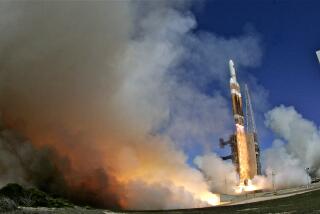Titan With Secret Payload Explodes Over Vandenberg : ‘Mushroom’ Cloud Drifts Over Coast
- Share via
A Titan 34-D rocket, powerful enough to put a large truck into orbit, exploded seconds after lifting off from Vandenberg Air Force Base at 10:45 a.m. today, sending a massive reddish cloud along the Central California coastline and rattling windows miles away.
There were no reports of injuries, and an Air Force spokesperson said damage was confined to the launch complex itself on a bluff above the Pacific.
The Air Force refused to reveal the nature of the payload aboard the giant rocket, other than to say it was “classified.”
Titan 34-Ds are used primarily to place large payloads into orbit around the Earth.
“I don’t know what was aboard and couldn’t tell you if I did,” said Col. Michael Boldrick of Vandenberg. “It looked like it exploded a few seconds after liftoff. It probably was still over land then.”
Air Force officials immediately downplayed any potential danger for coastal residents, but reporters in the area said evacuations were ordered from some communities near the sprawling base, located 130 miles northwest of Los Angeles.
One local official said the rocket exploded when it was only about 50 feet off the launch pad. A fisherman on the pier at Port San Luis about 60 miles north reported that the structure shook violently from the force of the explosion. Farther north in Morro Bay, smoke from the explosion also was visible.
Wreckage Into Ocean
“It really shook things,” said Jody Giannini, who runs a fishing service in Morro Bay.
A spokesman for Sen. Alan Cranston (D-Calif.) said in Washington that the Air Force told the senator that the wreckage crashed into the ocean.
As a precautionary measure, western Lompoc, the community nearest the base, was evacuated, according to Sandy Boyd, secretary to the city administrator of nearby Santa Maria. The National Park Service also ordered the evacuation of Anacapa Island, a small island in the Channel Islands National Park that is popular among tourists.
Some local officials minimized the danger.
“At this point there is no threat,” said Santa Barbara County public information officer Kathy McCann. “The cloud is moving . . . out to sea.”
Some school administrators in the area immediately sent children home after a “mushroom cloud” of unspent fuel appeared near the beach, but others issued instructions to keep all children inside.
Principal Kenneth McCalip said one parent “drove like crazy” to the small school in Casmalia in northern Santa Barbara County after seeing the cloud boiling up from the direction of the school.
McCalip said smoke from the explosion appeared to be drifting toward the school.
‘Can’t See Through It’
“It’s like a big fog bank of white smoke,” he said. “Very thick. You cannot see through it. It’s down at the end of our canyon toward the ocean.”
He said he sent the school’s 23 students home out of fear that coastal breezes could send the cloud “right here.”
The rocket uses liquid fueled motors and two solid rockets. It can place a 4,000-pound payload into stationary orbit 23,300 miles above the Earth or it can launch up to 34,900 pounds into low Earth polar orbit.
Stationary orbits are used primarily for communications satellites, because they remain fixed in one position over the Earth. Payloads launched by Vandenberg into low Earth orbits generally consist of spy satellites.
Another Titan 34-D was lost last Aug. 28 when one of its liquid-fueled engines shut down prematurely, and a sophisticated military satellite was destroyed when the rocket crashed into the Pacific.
More to Read
Sign up for Essential California
The most important California stories and recommendations in your inbox every morning.
You may occasionally receive promotional content from the Los Angeles Times.










